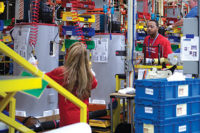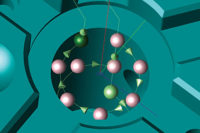Work holding fixtures for inspection devices have evolved over time and now have become, in some cases, as complex as the parts they are designed to hold. There was a day when some 1-2-3 blocks, knee blocks, double-sided tape and hot glue were all you needed to fixture parts for measurement on a coordinate measuring machine (CMM). Today’s world of ever-shrinking tolerances, more complex geometries and demanding production schedules requires a much more sophisticated approach to fixture design.
Back when CMM programs were stored on 3½ inch floppy disks, not much consideration was given to proper part constraints, datum simulators and gaging system variance or repeatability. The primary concern was: could the part be held adequately, without moving during inspection, with a minimal number of obstructions? Ease of setup for the operator was the top concern.
A SEA CHANGE
A transformation in thinking and a new approach to fixturing was required with the introduction of cutting edge technologies and production programs of the time such as the B-2 Stealth bomber in the ‘80s. This classified aircraft required the development of new manufacturing operations and techniques, thus driving corresponding changes in the measurement process. The introduction of exotic materials, high speed machining, free form geometries and a heavier reliance on large forgings resulted in machining operations that maximized throughput while still removing large amounts of material.
The results were parts suffering from an inordinate amount of distortion during production. This presented a fresh dilemma for fixturing at the CMM. Engineering organizations attempted to address the problems from a requirements standpoint. Certain constraints were allowed with specified limits applied to parts at designated locations which would mimic the assembly process. This new challenge gave rise to more complex fixturing systems with a tradeoff between simplicity, ease of use and functionality. The knee blocks and double-sided tape that once held parts for measurement gave way to baseplates, locators, force transducers and toggle clamps. Even today, part distortion issues still represent a challenge to airframe manufacturers.
GREATER FLEXIBILITY
The ‘90s ushered in greater awareness and a different viewpoint about CMM fixturing due to faster turnaround times, more part variety and a growing appreciation for its impact on the measurement process. This sea change called for flexibility and modularity. From a metrology standpoint, the ideal fixture still holds the part in an adequate fashion and orientation so the measuring device can do its job without influencing measurement results. While this approach may achieve the best possible results for a GR&R (Gage Repeatability and Reproducibility), reality and metrology all too often run into each other head on in a production environment.
To address all of the requirements of a measuring solution, fixture systems have evolved over the years. These kits now offer the user a choice of base plates, standoffs, risers, clamps and more that can be used in combination to build a fixture suitable for a particular job. Flexibility is the key element here. 3D CAD models of many fixture system components are now integrated in the offline environment of the most widely used CMM programming packages available today. Many manufacturers take advantage of the modular nature of these systems to save money and improve their overall results. They train their CMM operators how to assemble various components for a particular job, disassemble them and reassemble then in another fashion for the next job.
With the advent of noncontact and multi-sensor measuring CMMs, as well as laser-based and camera-based measuring systems, the variety of parts required to be measured is ever increasing. Correspondingly, the need for more flexibility, a larger array of fixture components and more robust work holding options is driving the development and direction of modern flexible fixturing systems. There has never been a greater selection of modular fixturing choices than there is today.
TODAY AND BEYOND
As the metrology industry continues to evolve, noncontact technologies have become more capable and automation systems have become more widely used. The combination of dedicated and modular flexible fixturing systems are increasingly being employed in manufacturing operations. As metrology is being deployed further upstream in manufacturing, gaging systems are integrated into the process and utilize the same work holding components. In some cases, these components must be designed upfront with inspection in mind.
As in-process inspection at the machine tool has become a more accepted practice, metrologists are seeing a benefit to measuring parts while fully constrained. This practice is providing more insight into the process itself and how it can be controlled better. This practice has a distinct advantage over waiting until the part hits a CMM later, which could be too late to take any corrective action.
Ever demanding cycle time reductions has led to the application of automated inspection systems throughout the manufacturing environment. These systems require equally sophisticated and carefully designed fixtures to properly address the metrology needs of the product, while not being a bottleneck to production. Simultaneously, there is a variety of dedicated, flexible and in some cases, very customized fixtures being utilized in quality laboratories for measuring parts and to benchmark their correlation to the manufacturing process. Some engineers are utilizing new methods such as 3D printing to quickly build a custom fixture that precisely nests the parts to be measured. As manufacturing moves forward, fixturing will surely follow its prevailing winds.



